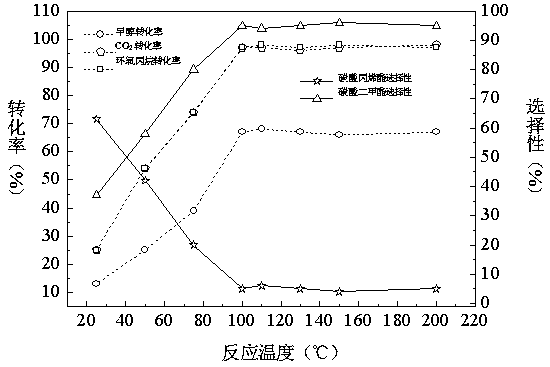Method for one-step synthesis of carbonic acid symmetric ester and co-production of 1,2-propanediol through propylene oxide
A technology of propylene oxide and propylene glycol is applied in the preparation of carbon dioxide or inorganic carbonate, the preparation of oxygenated compounds, chemical instruments and methods, etc. increase, etc.
- Summary
- Abstract
- Description
- Claims
- Application Information
AI Technical Summary
Problems solved by technology
Method used
Image
Examples
preparation example Construction
[0064] 1. Preparation method of mesoporous molecular sieve carrier:
[0065] In the present invention, orderly acid-base treatment is carried out on different carriers, and finally the molecular sieve carrier with the compound pore structure of mesoporous and micropores is prepared by high-temperature roasting. The purpose of the acid treatment is to remove the Al in the molecular sieve framework, so as to realize pore formation. The main function of the alkali treatment is to remove the Si in the molecular sieve framework to make the molecular sieve form a mesoporous structure. The preparation process includes the following steps:
[0066] 1) Dealumination: Add a certain mass of M-S carrier to a certain volume of acidic solution with a concentration of 0.11 mol / L, then stir and reflux in an oil bath at 100°C for 6 h, then filter, wash, and dry at 120°C for 8 h. The dealuminated M-S-DAl carrier is obtained.
[0067] 2) Desiliconization: Add the M-S-DAl carrier prepared in pro...
Embodiment 1
[0101] In the still of 50L slurry bed reactor, reaction pressure 10MPa, reaction raw material propylene oxide: carbon dioxide: methyl alcohol=1:1:3, drop into each 1.2 kg of the neutral catalyst that above-mentioned preparation method obtains respectively, reaction solution total volume is 40 L. The reaction was mechanically stirred at a reaction temperature of 100°C. After 10 hours of reaction, samples were taken for chromatographic analysis and calculation. The conversion rate of raw materials and product selectivity are shown in Table 1.
[0102]
[0103] When the reaction is catalyzed by a neutral catalyst, the conversion rates of propylene oxide (PO) and carbon dioxide are basically the same, because propylene oxide only reacts with carbon dioxide to form propylene carbonate, and no other side reactions occur. But when the basic catalyst 10%BaO-20%CaO / Al 2 o 3 When the reaction is catalyzed, the selectivity of propylene oxide is significantly higher than that of carb...
Embodiment 2
[0105] In a 50L slurry bed reactor, the reaction pressure is 10MPa, the reaction raw material propylene oxide: carbon dioxide: various alcohols = 1:1:3, put in 15%PdO-8%SrO 2 -3%Ga 2 o 3 / Zn-meso-Y catalyst 1.2kg, the total volume of the reaction solution is 40 L. The reaction was mechanically stirred at a reaction temperature of 100°C. After 10 hours of reaction, samples were taken for chromatographic analysis and calculation. The conversion rate of raw materials and product selectivity are shown in Table 2.
[0106]
[0107] It can be seen from Table 2 that when different alcohols are used as reaction raw materials to synthesize symmetrical carbonate esters, the reaction results are quite different. As the R group becomes more complex, the conversion rate of ROH gradually decreases, and the selectivity of symmetrical carbonate esters also gradually decreases. . The reason is that as the R group becomes more complex, the steric hindrance of ROH becomes larger, and it i...
PUM
| Property | Measurement | Unit |
|---|---|---|
| pore size | aaaaa | aaaaa |
| melting point | aaaaa | aaaaa |
| boiling point | aaaaa | aaaaa |
Abstract
Description
Claims
Application Information
 Login to View More
Login to View More - R&D
- Intellectual Property
- Life Sciences
- Materials
- Tech Scout
- Unparalleled Data Quality
- Higher Quality Content
- 60% Fewer Hallucinations
Browse by: Latest US Patents, China's latest patents, Technical Efficacy Thesaurus, Application Domain, Technology Topic, Popular Technical Reports.
© 2025 PatSnap. All rights reserved.Legal|Privacy policy|Modern Slavery Act Transparency Statement|Sitemap|About US| Contact US: help@patsnap.com



